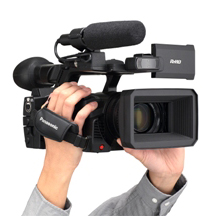Panasonic to Begin Shipping AJ-PX270, First P2 HD Handheld Camcorder With AVC-ULTRA Recording |

Available in March, New Handheld Delivers AVC-ULTRA’s High Quality and Versatile Efficiency; Offers Flexible 3G/4G/LTE Wireless Mobility |
|
NEWARK, NJ (February 27, 2014) – Panasonic today announced delivery and pricing of the new AJ-PX270, the company’s first P2 HD handheld camcorder with AVC-ULTRA recording. Combining the high quality and incredible efficiency of low bit rate recording and the flexibility of 3G/4G/LTE wireless mobility, the five-pound PX270 provides all the key functionality of Panasonic’s high-end, shoulder-mount camcorder (the AJ-PX5000 with AVC-ULTRA). It also features newly-developed high-sensitivity, low-noise 1/3" 3-MOS imagers to produce stunning pictures, even in low light conditions. The ultimate news acquisition tool, the PX270 will be equally suitable for a wide range of sports, corporate, education and event applications. The PX270 will be available in March at a suggested list price of $6,350.00. With its innovative AVC-ULTRA codec, the PX270 features a wide range of recording modes. For high-quality recording, the camera records in 100Mbps AVC-Intra100, as well as 200 Mbps AVC-Intra200 (optional: available in the near future). For applications where file size is critical, e.g., for wireless feeds, the camcorder incorporates a choice of AVC-LongG quality levels, including AVC-LongG50, AVC-LongG25 and AVC-LongG12. These 10-bit, 4:2:2 sampled codecs (LongG50/25*) record in much smaller file sizes, saving storage cost and transfer time while maintaining equal or better video quality to existing legacy codecs. Addressing the need for high-speed file exchange, the PX270’s high-resolution AVC-Proxy encodes in parallel with higher bandwidth production formats, enabling fast, efficient offline editing, at bit rates from 6 Mbps down to 800kbps. The camcorder also offers legacy recording in DVCPRO HD, DVCPRO50, DVCPRO and DV. "The PX270’s scalable, flexible AVC-ULTRA codec encompasses recording 10-bit 4:2:2 HD at 25Mbps, a dramatic achievement meaning that broadcast-quality HD can be transported over fast broadband networks at high speed, and users can record long-format material to a single or dual microP2 card," said Steven Cooperman, Senior Product Manager, Panasonic System Communications Company of North America. "The 200Mbps option is a testament to the camera’s flexibility, with its visually lossless compression and master-level quality." A newly designed, compact, 22X zoom lens offers a wide 28 mm to tele 616 mm (35mm equivalent) zoom range. The PX270’s three manual operation lens rings — zoom, focus and iris — provide a comfortable manual control similar to interchangeable lenses, but without the need for actual lens changes. The zoom ring's solid feel and smooth action allows delicate ultra-slow zooming. In addition, the camera’s multi-step zoom control provides fast response and smooth zoom action, providing the creative freedom every camera operator wants. The zoom control on the handle enables variable speed zoom, allowing fine zoom control even for low angle shots. Networking functions are included as standard, and options are available to allow for proxy video to be automatically uploaded to the cloud and for compatibility with a planned cloud workflow (scheduled for near future). The PX270 features a Wireless LAN function via an optional Wireless LAN dongle and supports existing Panasonic live uplink solutions. Dongle support for wireless workflow over a mobile 3G/4G/LTE network is also scheduled for the near future. Accessing these wireless features, PX270 operators can easily uplink low-bit rate proxy data and full-quality broadcast content. The handheld camera’s network function makes the production workflow more efficient and accelerates the broadcasting workflow from shooting to on-air. Two microP2 card slots enable the ultimate cost-effective operation. The microP2 card, with the same reliability as the P2 card, can be used without an adapter. A P2 card slot and SD card slot are also included. The PX270 is equipped with Panasonic’s Emmy® Award-winning Chromatic Aberration Compensation (CAC) technology to maximize lens performance; a Dynamic Range Stretch (DRS) function to optimize scene image contrast at the pixel level, reducing overexposure and crushed shadow content and dramatically improving human skin rendition; and a highly accurate flash band detection and compensation algorithm that minimizes partial image exposure due to strobe lighting. The camcorder delivers seven-mode (HD/SD/FILMLIKE 1/FILMLIKE 2/FILMLIKE 3/FILM-REC/VIDEO-REC) gamma selection and extensive digital image settings, including 12 + 3 Axis Matrix Control to fine tune skin tone. Other key features include the industry’s first OLED viewfinder for true-to-life tones, and the industry’s first 1.56-megapixel high-resolution LCD monitor. Audio capabilities include two, separated XLR audio inputs, and recording up to four channels of 48kHz, 24-bit audio in AVC-Intra formats (16-bit in AVC-LongG, DVCPRO HD, DVCPRO and DV). An XLR connector is conveniently located at the rear, off to the side for easier cable connection during handheld shooting. In another industry first, the audio recording level control is located towards the front for easy adjustment during shooting. Standard features include a wide range of shutter speed in 60i/60p mode (1/60 to 1/2000), 50i/50p mode (1/50 to 1/2000), 30p mode (1/30 to 1/2000), 25p mode (1/25 to 1/2000) and 24p mode (1/24 to 1/2000); Digital Zoom function for 2×, 5× and 10× boosts; and a four-position optical ND filter (OFF, 1/4 ND, 1/16 ND, 1/64 ND.) *AVC-LongG12 records 8-bit, 4:2:0 video. |